|

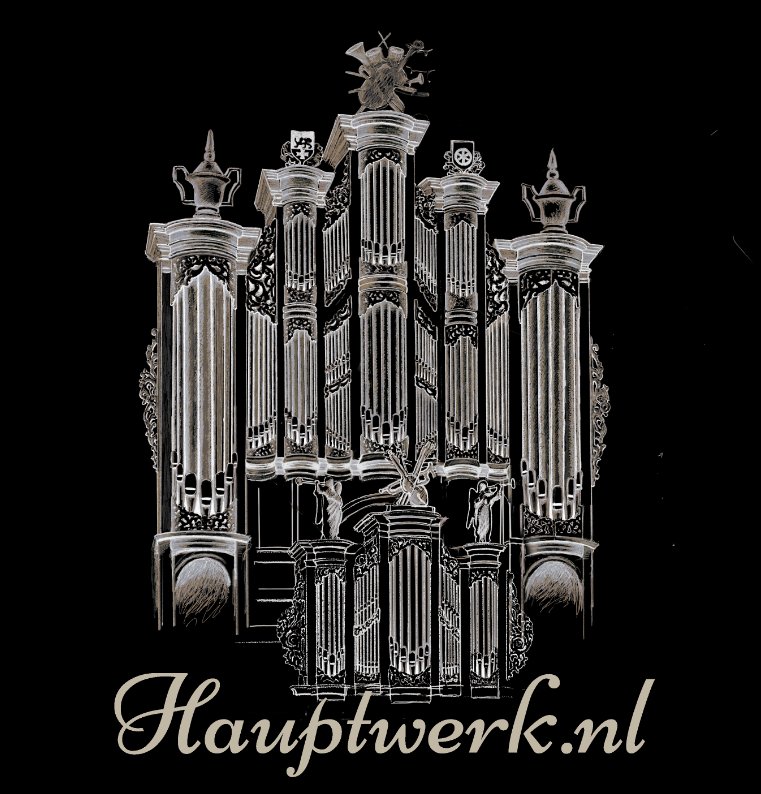







|
Er wordt nog aan gewerkt!

|
|
1. The main organ of the St. Janskerk of the city of Schiedam
|
The Niehoff organ
The oldest reference to an organ in the main church of Schiedam goesback to the year of 1498, when Albert Dircks was appointed organist.
Aroundthe year of 1580 the famous organ builder Hendrik Niehoff made a new instrumentconsisting of two manuals, Main (Hoofdwerk) and Positif (Rugwerk). The organ cases were delivered with beautifully
painted panels.
In the year of 1680, Appolonius Bosch expanded the organ with a modest third manual (Bovenwerk). Supposedly, the wind chests were replaced at the sametimeandin view ofthe fact that the yearof
"1680" was mentioned betweenthe rowsof pipes between the main andpositif manuals, the layout of the organ front was modified at the same time.
In the year of 1712 , Jacob Cools enlarged the organ with a free pedal, situated in new side cases. The robust rowsofpipes of the pedal resulted in quite a different look of the organ, by the effect of width.
The ornamental art work between the main case and the pedal cases were created by the Rotterdam sculptur Alexander Pluskens, whereas sculptur Francois van Douwe madethecarving on the pedal- and
main cases. The sculpture of the trumpet blowing angel on top of the middle toweris also of his hands.
In the year of 1737, a fifth bellow and a new pedal were made by Rudolph Garrels. At that time, the specification presumably was:
|
|
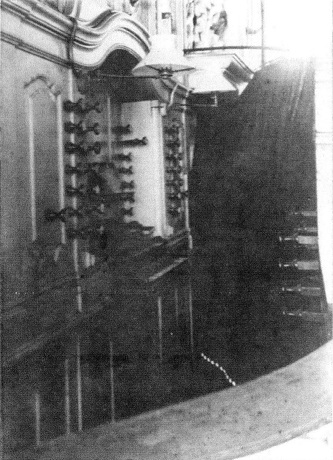
|
Manual
Prestant 16' D
Prestant 8'
Holpijp 8'
Octaff 4'
Quint 3'
Octaff 2'
Gemshoorn 2'
Sexquialter 2 ranks
Mixtuur 2-3 ranks
Scherp 2-3 ranks
Cornet 6 ranks Disc.
Trompet 8'
Pedals
Subbas 16'
Bordon 16'
Prestant 8
Quint 6'
Octaaff 4'
Trompet 16'
|
Positif
Holpijp 8'
Prestant 8' D
Prestant 4'
Octaaff 2'
Quint 1 1/2'
Octaaf 1'
Sexquialter 3 ranks Disc.
Bovenwerk (Upper)
Baarpijp 8'
Quintadeen 8'
Tolkan 4'
Vox Humana 8'
|
The instrument endured the 19" century pretty well. Apart from the usual maintenanceactivities, only minor changes wereapplied.
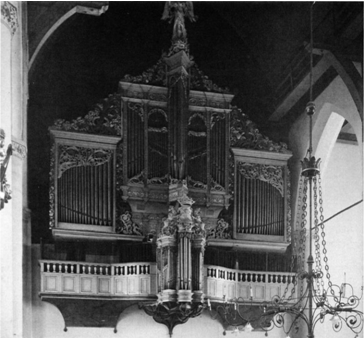
The Niehoff organ (1915)
The Standaart-organ
At the beginning of the 20"century, another restoration became necessary. In the year of 1915 the then organist of the main church, Hendrik Jan Pieter Textor (1847 -1929), a pupil of Samuel de LangeSr.,
advised to have the organ renovated by the Schiedam organ builder named Standaart.
Undoubtedly, Textor was charmed by the modern,industrial organ building practiced by Standaart. The numerous church- and theatre organs supplied by Standaart in the Schiedam region
(among others the NPB-church and the Passagetheatre Schiedam,the City Hall of Rotterdam, various organsin the city of Vlaardingen) were built in line with the then modern pneumatic system.
Not bothered by anyhistorical notion, the Niehoff organ was demolished and replaced by a new pneumatic organ, situated behind the old front.
For that purpose, the case of the main manual became more deep and broad to makeplace for the main and swell manuals. The now idle case of the Rugwerk offered room for musicliterature.
The Baarpijp 8', Quintadeen 8' and part of the Octave 4' (pedal) of the old Niehoff pipes were retained for use in the new organ.
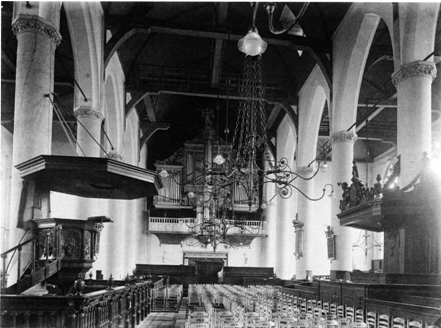
Church interior (1915)
The specification was:
|
Hoofdwerk (Great)
Bourdon 16' D
Prestant 8'
Roerfluit 8'
Octaaf 4'
Quint 2 2/3'
Octaaf 2'
Cornet 6 rangs
Mixtuur 5 rangs
Trompet 8'
Pedals
Prestant 16'
Subbas 16'
Prestant 8
Octaaf 4'
Fluit 2'
Trombone 8'
|
Bovenwerk (Upper)
Quintadeen 16'
Voolprestant 8' D
Holpijp 8'
Openfluit 8'
Prestant 4'
Fluit 4'
Woudfluit 2'
Terts 1 3/5'
Hobo 8'
Various couples
and playing aids
|
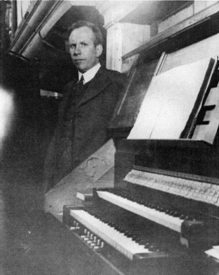
Adriaan C. Schuurman, organist of the Grote
of St. Janskerk 1929-1938, next to the Standaart console
|
During the church restoration of 1945-1948, the organ front was restored, with the original painting showing again.
Flentrop company carried out repairs in 1952.
After 50 years, the "Standard Device", as organist Jacques P. Bekkers called it, was finished.
At that time it had long been the intention to build a new mechanical organ using the historic cases.
The Flentrop-organ
In the year of 1971, Flentrop Orgelbouw BV at Zaandam wascharged with the building of a new organ in the style of the remaining historic Niehoff pipe material.
Therefore, the new pipes were madeof metal with high lead contents and wide scales. The organ sounded in Werckmeisterpitch. In this way, front and organ character werein uniformity again. The
instrument wasdelivered in the year of 1975.
Re-intonation
In the year of 1993, re-intonation of the organ took place at the request of organist André Verwoerd. Windpressure was deminished to achieve a more sonorous sound.
These changes wereapplied by Flentrop Orgelbouw.After that, the organ builder HermanPilgrim revised the reeds and added a Cymbelstar in the year of 2006.
Renovation and enlargementof the organ
In the year of 2011, an overhaul was done by J.L. van den Heuvel Orgelbouw. The extensive maintenance was concentrated on cleansing and restoration of pipes, renewal of lead conducts and
repair of tracker action. Independent windsupply wasconstructedfor the pedal, consisting of two motorsand bellows. Behind the two 17" century pedal cases, new electrical pedal windchests were
placed.
In the first instance, two woodenpedal stops were placed on these twochests: - Prestant 16', woodenpipes madebyG.van der Kley (1920), coming from the former Oosterkerk,
later on added to the organ of the former Magnalia Dei church, both at Schiedam - Roerquint 12' , a new stop made by Van den Heuvel Orgelbouw.
Space was created for placing a Fagot 32', which was realized in January 2012 and put into service on the occasion of Queens Birthday, April 30th of that year.

Source: Program booklet "Orgelconcerten 2019" of the "Stichting Muziek Grote of Sint Janskerk".
|
|
Hauptwerk.nl is an initiative from Sygsoft Holland. KvK 93602855. Last updated
2024-04-20
|
|
| |